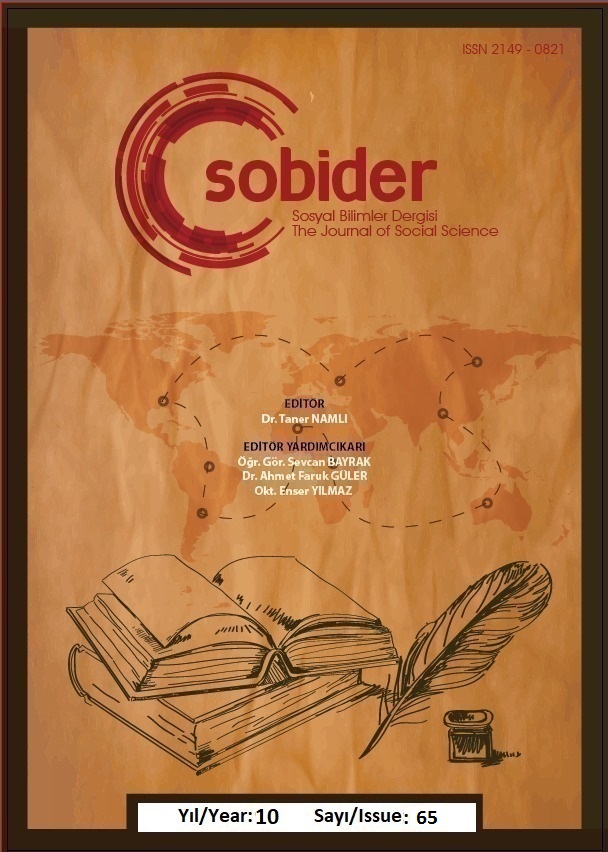Author :
Abstract
F. Kafka’nın (1883-1924) ilk basımını 1925 tarihinde yapan meşhur romanı Dava (Der Prozeß) içerisinde yer alan “Yasa Önünde” (Kafka 2012: 208-210) mise –en abyme’nin bir kıssa niteliği taşıyan metaforik öğelerini, sınır, eşik, egemenlik, sanat türleri arasındaki farkın gerilimi ve bunların sinemadaki yansımalarını tartışmaya açma gayreti taşıyan çalışmamızda birbiri içine geçmiş üç temel eksen takip edilmiştir. Birinci eksen, yasanın doğrudan gündelik yaşantılara sirayet eden, yaşamı düzenlemede öncelik talep eden yapısıyla ilişkilendirilebilecek ahlaki boyutuyla; ikinci eksen, yasal olan ve yasadışı olan arasındaki gerilimin pratik ihtiyaçlarla kıyaslandığında sınır-aşımına ne denli müsamahalı olabileceği ile; üçüncü eksen ise hem sanat yapıtının türünü belirlemede sanatçının rolünün egemenlik mefhumu ile ilişkisi hem de erteleme ediminin yasal dispozitiflerle işbirliğinin latent yapısıyla ilgilidir. Bu üç eksen açımlanırken ve aralarındaki ilişki betimlenirken J. Derrida’nın (1930-2004) “Devant la loi” (Derrida 1985: 87-140) metninden, G. Agamben’in (1942-) “Stato d'eccezione” (Agamben 2003) ve “Homo sacer. Il potere sovrano e la nuda vita” (Agamben 2005) metinlerinden istifade edilmiş, bu metinler aracılığıyla yürütülen teorik çalışmanın metaforlarla ilişkisini sanat eserleri arasındaki söz konusu sınır-aşımına örnek teşkil edebilecek sinemanın imgelerinden yararlanarak gösterebilmek için ise yönetmeni Steven Spielberg, senaristleri Sacha Gervasi ve Jeff Nathanson olan “The Terminal” (2004) filmi incelemeye tabi tutulmuştur. “Yasa Önünde” meseli ile “The Terminal” filminin aralarındaki devasa zaman farkına rağmen benzer imgeleri kullanarak, benzer bir durumla ilgili taşıdıkları satirik anlatım çalışmamızın temel uzlaşım noktasıdır.
Keywords
Abstract
The metaphorical elements of mise -en abyme, which is included in F. Kafka's (1883-1924) famous novel The Trial (Der Prozeß), which was first published in 1925, and in “Before the Law” (Kafka 2012: 208-210), in our work, which tries to discuss the tension of the difference between borders, thresholds, sovereignty, art types and their reflections in cinema, three intertwined axes are followed. The first axis is the moral dimension that can be associated with the structure of the law that directly affects daily lives and demands priority in regulating life; the second axis is about how tolerant of cross-border crossing can be compared to practical needs of the tension between the legal and the illegal; the third axis is related both to the relationship between the role of the artist in determining the type of artwork and the notion of sovereignty, and to the latent nature of the act of procrastination in cooperation with legal dispositifs. While explaining these three axes and describing the relationship between them, from J. Derrida's (1930-2004) "Devant la loi" (Derrida 1985: 87-140), G. Agamben's (1942-) "Stato d'eccezione" (Agamben 2003) and “Homo sacer. Il potere sovrano e la nuda vita” (Agamben 2005) texts were used, and the director Steven Spielberg, screenwriters Sacha Gervasi and Jeff Nathanson's film "The Terminal" (2004) was subject to scrutiny, in order to show the relationship between metaphors and the theoretical work carried out through these texts by making use of the images of cinema, which can serve as an example of the said cross-border between works of art. Despite the huge time difference between the parable "Before the Law" and the movie "The Terminal", the satirical narrative of a similar situation using similar images is the main point of agreement of our work.
